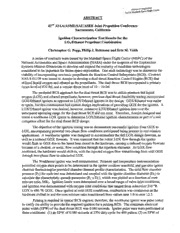
NASA Technical Reports Server (NTRS) 20060047786: Ignition Characterization Test Results for the LO2/Ethanol Propellant Combination PDF
Preview NASA Technical Reports Server (NTRS) 20060047786: Ignition Characterization Test Results for the LO2/Ethanol Propellant Combination
ABSTRACT 42ndA IAA/ASME/SAE/ASEE Joint Propulsion Conference Sacramento, California Ignition Characterization Test Results for the Lofithano1 Propellant Combination Christopher G. Popp, Philip J. Robinson and Eric M. Veith A series of contracts were issued by the Marshall Space Flight Center (MSFC) of the National Aeronautics and Space Administration (NASA) under the auspices of the Exploration Systems Mission Directorate to develop and expand the maturity of candidate technologies considered to be important for future space exploration. One such technology was to determine the viability of incorporating non-toxic propellants for Reaction Control Subsystems (RCS). Contract NAS 8-01 109 was issued to Aerojet to develop a dual thrust Reaction Control Engine (RCE) that utilized liquid oxygen and ethanol as the propellants. The dual thrust RCE incorporated a primary thrust level of 870 lbf, and a vernier thrust level of 10 - 30 lbf. The preferred RCS approach for the dual thrust RCE was to utilize pressure-fed liquid oxygen (LOX) and ethanol propellants; however, previous dual thrust feasibility testing incorporated GOX/Ethanol igniters as opposed to LOX/Ethanol igniters in the design. GOX/Ethanol was easier to ignite, but this combination had system design implications of providing GOX for the igniters. A LOWEthanol igniter was desired; however, extensive LOWEthanol ignition data over the anticipated operating range for the dual thrust RCE did not exist. Therefore, Aerojet designed and tested a workhorse LOX igniter to determine LOX/Ethanol ignition characteristics as part of a risk mitigation effort for the dual thrust RCE design. The objective of the ignition testing was to demonstrate successful ignition from GOX to LOX, encompassing potential two-phase flow conditions anticipated being present in real mission applications. A workhorse igniter was designed to accommodate the hll LOX design flowrate, as well as a reduced GOX flowrate. It was reasoned that the initial LOX flow through the igniter would flash to GOX due to the latent heat stored in the hardware, causing a reduced oxygen flowrate because of a choked, or sonic, flow condition through the injection elements. As LOX flow continued, the hardware would chill-in, with the injected oxygen flow transitioning from cold GOX through two-phase flow to subcooled LOX. The Workhorse igniter was well instrumented. Pressure and temperature instrumentation permitted oxygen state points to be determined in the igniter oxidizer manifold, and gas-side igniter chamber thermocouples provided chamber thermal profile characteristics. The cold flow chamber pressure (Pc) for each test was determined and coupled with the igniter chamber diameter (Dc) to calculate the characteristic quench parameter (Pc x Dc), which was plotted as a function of core m. mixture ratio, Ignition limits were determined over a broad range of valve inlet conditions, and ignition was demonstrated with oxygen inlet conditions that ranged from subcooled 2 10 OR LOX to 486 OR GOX. Once ignited at cold GOX conditions, combustion was continuous as the hardware chilled in and the core mixture ratio transitioned from values near 1.0 to over 12.5. Pulsing is required in typical RCS engines; therefore, the workhorse igniter was pulse tested to verify the ability to provide the required ignition for a pulsing RCE. The minimum electrical pulse width (EPW) of the dual thrust RCE was 0.080 seconds. Igniter pulse tests were performed at three conditions: (1) an EPW of 0.080 seconds at 25% duty cycle for 400 pulses; (2) an EPW of Ignition Characterization Test Results for the Lofithano1 Propellant Combination (cont’d.) 0.160 seconds and a 5% duty cycle for 124 pulses; (3) an EPW of 0.160 seconds and a 50% duty cycle for 380 pulses. Successful ignition of LOX/Ethanol was demonstrated over a broad range of valve inlet conditions, with the empirically determined LOXEthanol ignition limits extending the previous database established for GOX/Ethanol ignition limits. Although the observed chill-in characteristics of the hardware varied significantly with flowrate, ignition was readily achieved. Combustion was marginal at extremely fuel-rich conditions, and it fluctuated as the oxygen passed through the two- phase flow regime during the period of hardware chill-in. Pulse testing showed good repeatability with 100 percent re-ignition for all pulses. Certain pulse-to-pulse repeatability requirements for actual RCS operation may necessitate establishment of minimum oxygen flow rates and engine thrust levels for satisfactory engine performance.
